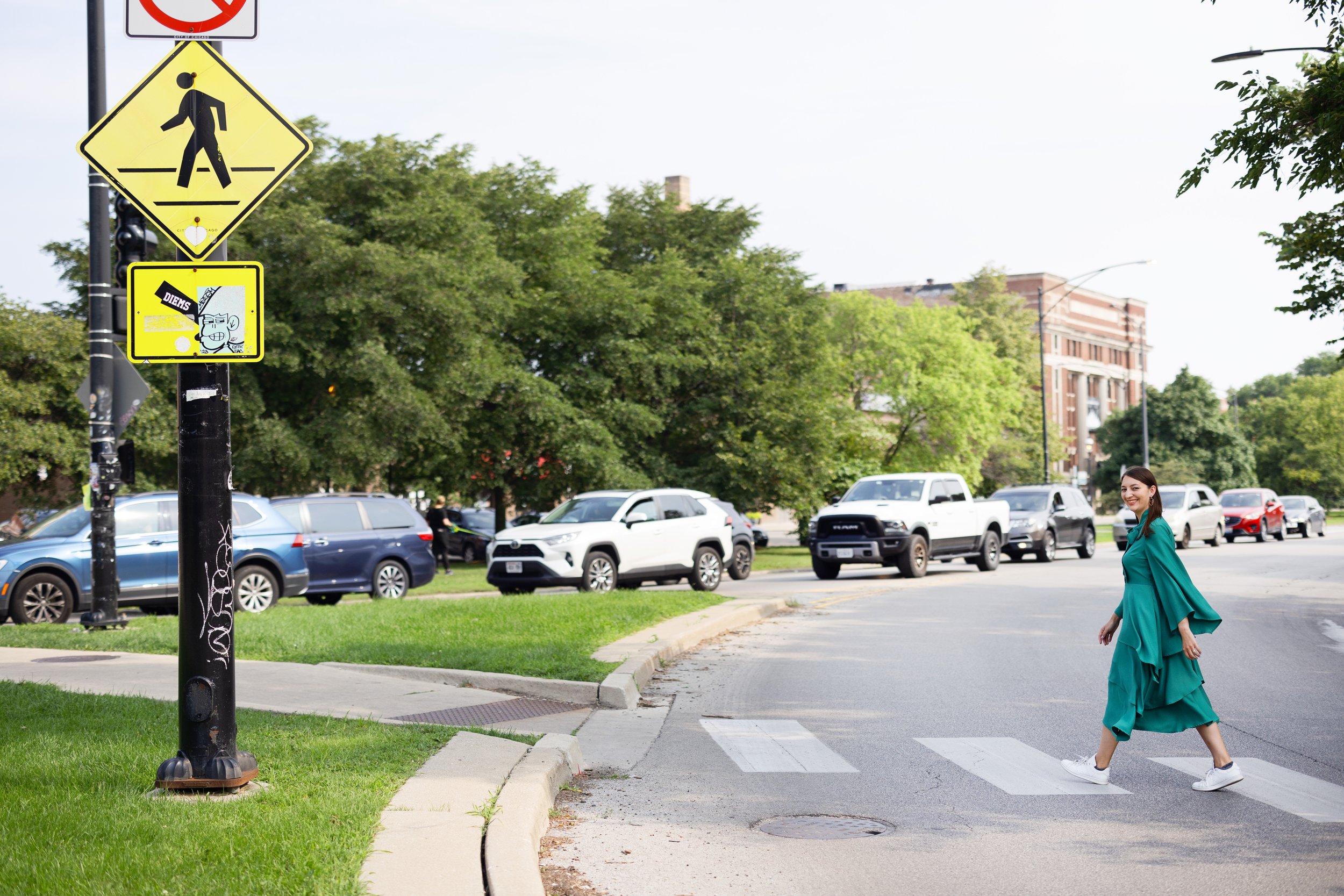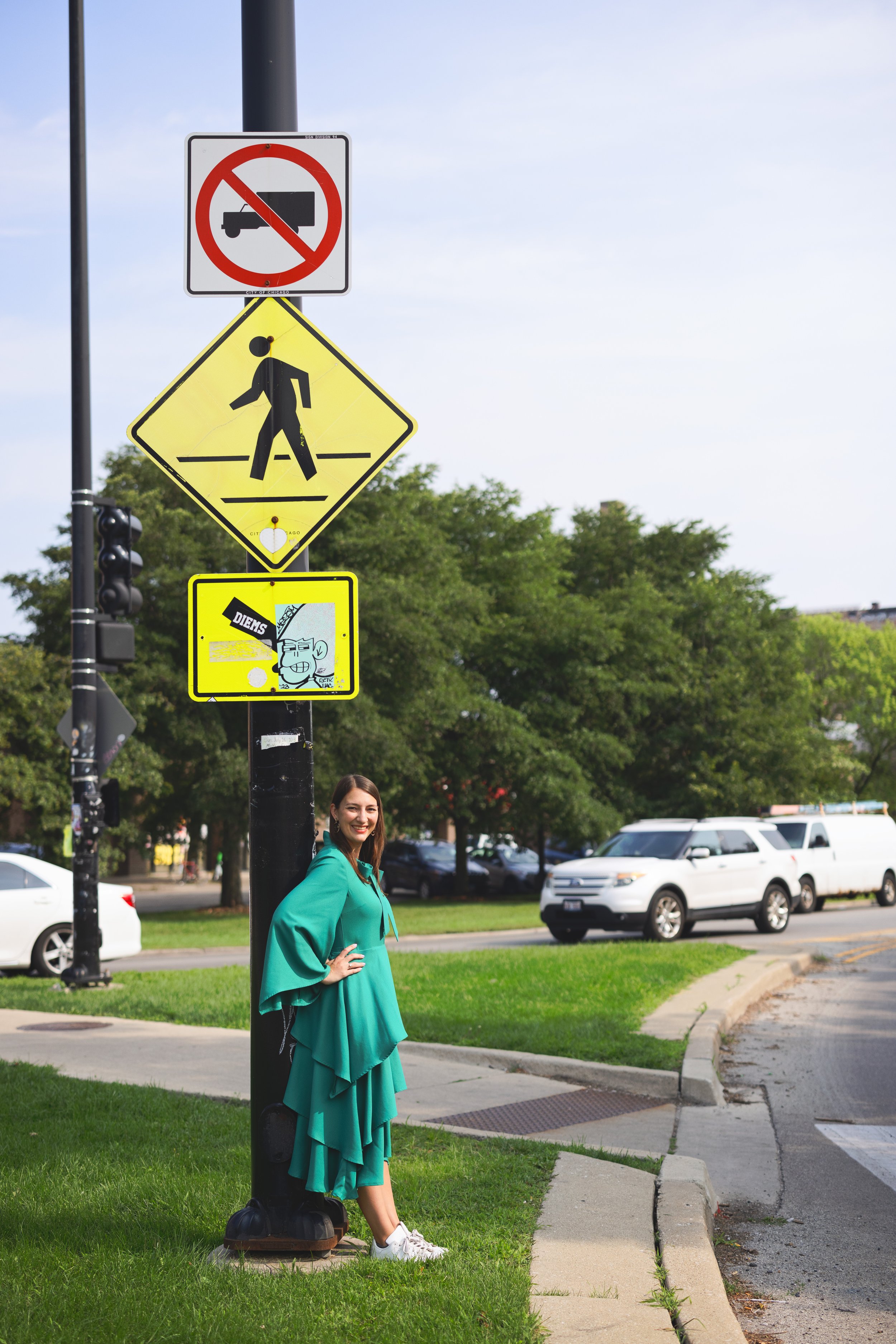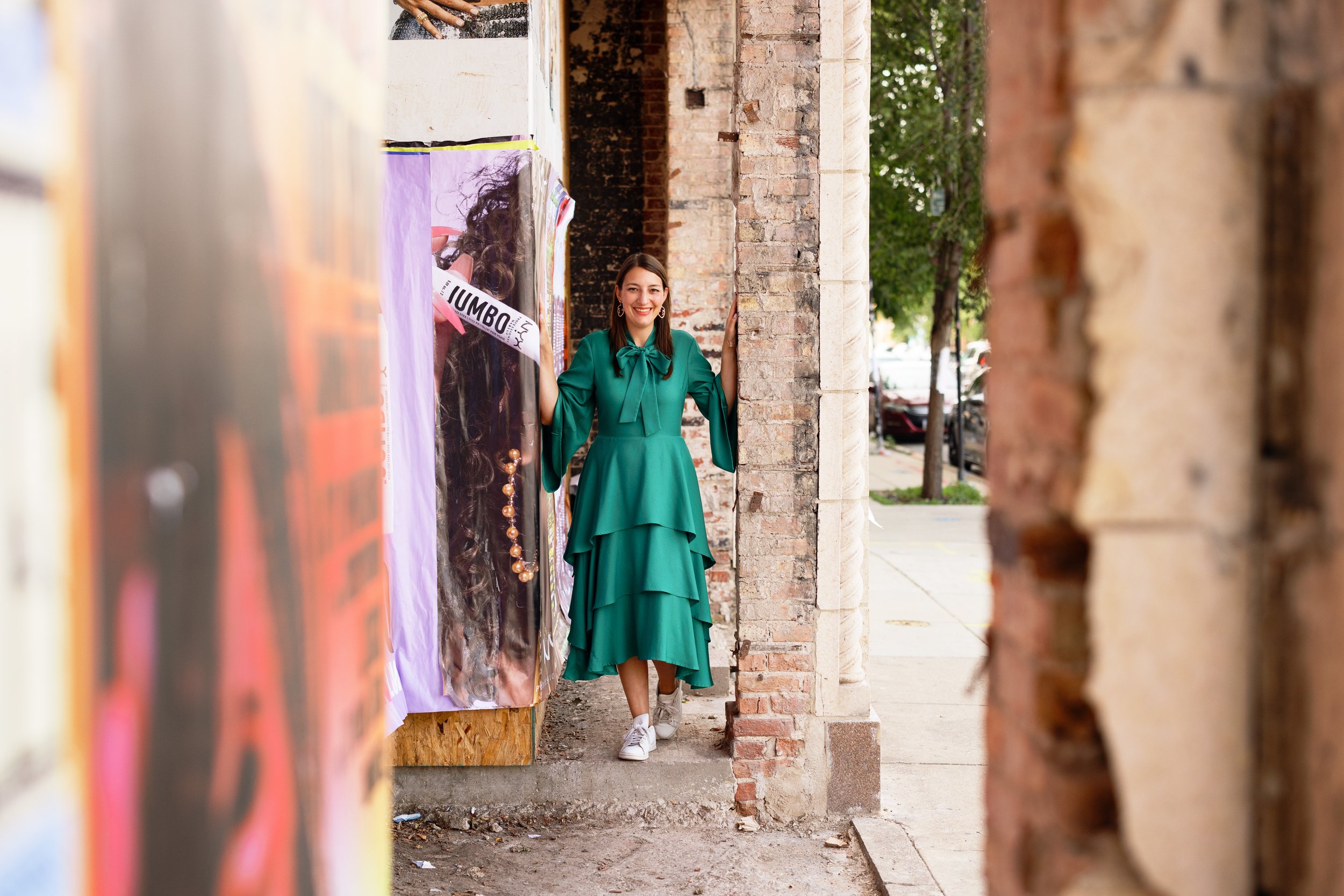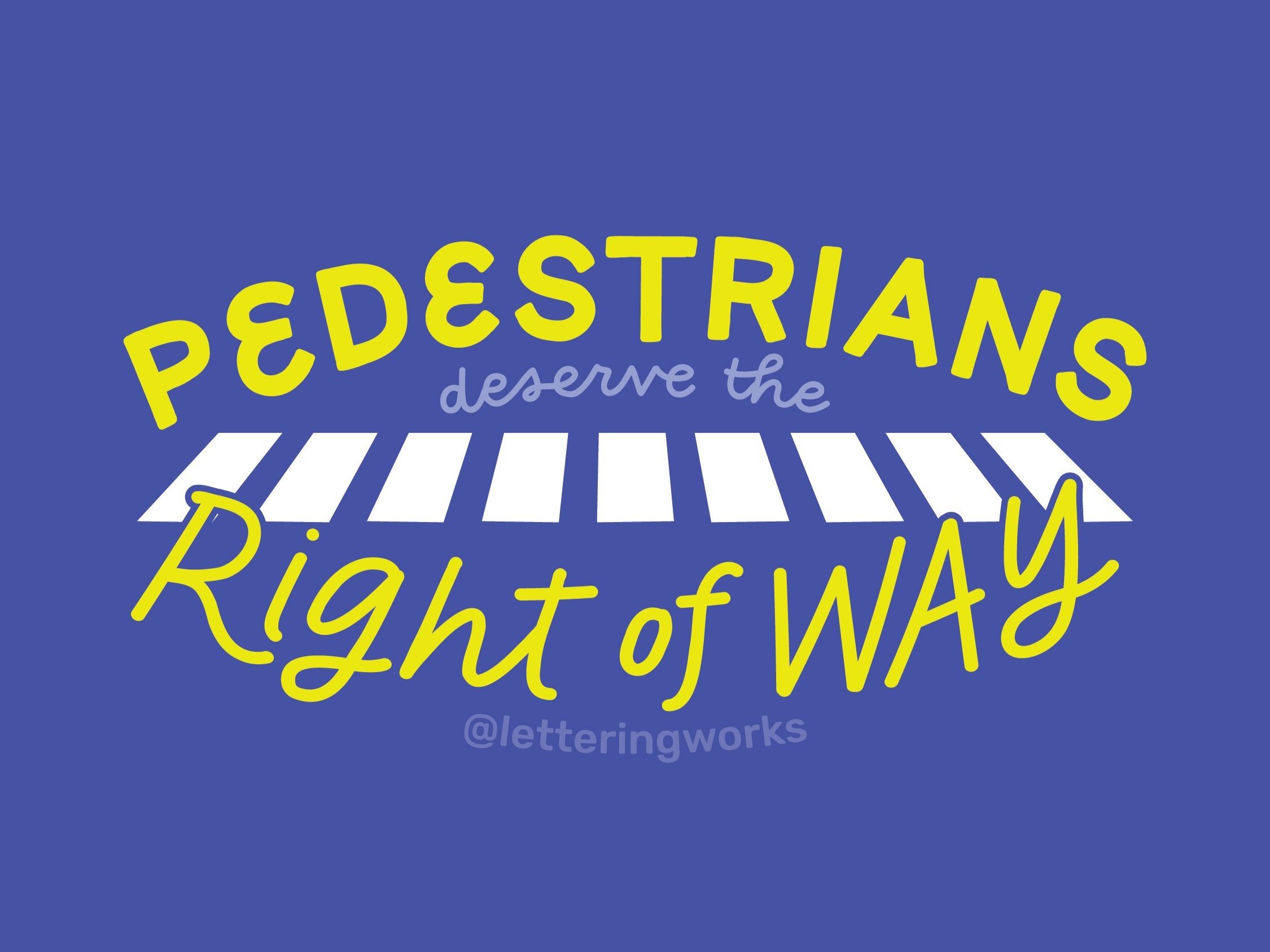Walking In Style: Lettering Works Launches Pedestrian By Choice Collection
Logan Square, Chicago based artist, Chelsie Tamms; Photo by Shannon of S.D.Wyatt Photography
Taking the walkway less traveled and leading a life where every step carries meaning.
In a world where wheels dominate the roads and speed is often favored over serenity, a distinctive movement is gaining momentum – that of the pedestrian by choice. Beyond mere transport, it's a philosophy, a stride of independence, and a conscious step towards health, sustainability, and a more connected existence.
As a pedestrian by choice for the past four years of living in Chicago, I’ve enjoyed the countless benefits of not relying on a car to get around. I’ve said goodbye to the hassles of parking, car payments, car insurance, and traffic in exchange for a deeper awareness and connection to my community, all while diligently working to get my 8,500+ steps in per day.
In addition to walking whenever I can, I do use public transit often and am a huge advocate for more people giving it a chance as one of their primary modes of transportation. Walking isn’t for everyone and doesn’t have to be. If you are able, I encourage you to make walking a priority.
I hope this project unites those who rely on walking as their primary mode of transportation and cultivates empathy from others who use and choose different modes of getting around.
Photo by Shannon of S.D.Wyatt Photography
Ten Reasons to Choose Walking as a Primary Mode of Transportation:
Health and Fitness: Walking is a natural way to stay physically active. It helps maintain a healthy weight, strengthens muscles, improves cardiovascular health, and enhances overall fitness levels.
Eco-Friendly: Walking produces zero emissions, making it one of the most environmentally friendly modes of transportation. By choosing to walk, you significantly reduce your carbon footprint and contribute to cleaner air and a healthier planet.
Cost-Effective: Walking doesn't require purchasing fuel, tickets, or maintenance for vehicles. It's a cost-effective way to get around that doesn't strain your wallet.
Reduced Stress: Walking can be meditative and stress-relieving. It gives you time to clear your mind, enjoy the surroundings, and arrive at your destination feeling refreshed.
Exploration: Walking allows you to discover your environment at a comfortable pace. You'll notice details and landmarks that you might miss when traveling in a vehicle.
No Traffic Jams: Say goodbye to frustrating traffic congestion and long waits. As a pedestrian, you're not stuck in traffic, and you have the freedom to navigate through urban areas more efficiently.
Community Engagement: Walking encourages interaction with neighbors and local businesses. It fosters a sense of community, as you're more likely to stop and chat or explore shops and cafes along the way.
Flexibility: You're not tied to schedules or routes like public transportation or driving. Walking gives you the flexibility to take detours, make spontaneous stops, and adapt to changing circumstances easily.
Mindful Living: Walking cultivates mindfulness as you're more connected to your surroundings and in tune with your body. It's a chance to appreciate the small things and be present in the moment.
Safety: Walking is generally safer than other modes of transportation. You're not exposed to the risks associated with collisions or breakdowns that vehicles might encounter.
Embracing a pedestrian lifestyle brings numerous benefits to your health, finances, and the environment, while also offering a unique perspective on your surroundings and fostering a sense of well-being.
Photos by Shannon of S.D.Wyatt Photography
Being a Pedestrian by Choice Comes with its Challenges
From safety concerns (namely vulnerability to vehicles and lack of pedestrian infrastructure) to exposure to poor weather conditions to time constraints to physical exertion to limited carrying capacity to navigating vehicular traffic to social stigma and accessibility issues, there are some real challenges and existing barriers to adopting the pedestrian by choice lifestyle.
Despite these challenges, advocating for pedestrian-friendly infrastructure and safety measures can help create a more walkable environment and address some of these issues.
A Closer Look at the Designs (and Why Their Messages are Important):
Pedestrian By Choice
The phrase "Pedestrian by choice" refers to a deliberate decision or preference of an individual to primarily use walking as their mode of transportation.
Reasons for being a “Pedestrian by choice” can include health benefits, environmental concerns, cost-effectiveness, or a desire to engage more closely with their surroundings.
This lifestyle choice reflects a commitment to a slower-paced, more sustainable, and often more interactive way of moving through the environment.
Give Pedestrians a Green Light for Safety & Respect
This phrase is a call to action for creating an environment where pedestrians are given the right of way and treated with courtesy, fostering safer interactions between pedestrians and other road users like people driving cars and riding bicycles. It combines the concepts of safety, courtesy, and responsible road behavior to advocate for a more pedestrian-friendly and respectful urban landscape.
Slow Down for Pedestrians
This phrase encourages a responsible and considerate driving attitude, promoting the safety and well-being of both pedestrians and drivers. It underscores the importance of sharing the road harmoniously and reflects a commitment to reducing the risk of avoidable crashes involving pedestrians.
Encountering aggressive drivers as a pedestrian can not only lead to frustration, but legitimate fear of serious injury and death. I believe this could be entirely avoidable if drivers take this message to heart and, at a minimum, reduce their speed when approaching areas where pedestrians are likely to be present, such as crosswalks, sidewalks, or pedestrian zones.
Stopping at Crosswalks is Not Optional
Simply put, people driving cars have a legal and ethical obligation to come to a complete stop at crosswalks when pedestrians are crossing or waiting to cross the road.
In many jurisdictions, traffic laws require drivers to yield the right of way to pedestrians at crosswalks. This phrase underscores the fact that this isn't a matter of choice or personal preference for drivers—it's a legal requirement and a fundamental safety measure.
As a community, we have the responsibility to protect each other and create a safer road environment for everyone.
It can be frustrating to be seen as an obstacle by people driving cars and even have to navigate weaving in and out of the vehicles of drivers who refuse to slow down and yield. Friendly reminder: passing in a crosswalk is illegal and creates incredibly unsafe conditions for all those involved.
Roads are for Sharing
Public roads and spaces are meant to be used by a variety of users, including pedestrians, cyclists, motorcyclists, and motorists. Coexistence and mutual respect among all road users is a necessity.
No single mode of transportation has exclusive rights over the road. Instead, all users have a right to access and use the road safely and responsibly. This phrase encourages a sense of responsibility and consideration, reminding everyone to be mindful of others and to follow traffic rules and norms to prevent conflicts and ensure the safety of everyone involved.
This reminder feels especially necessary for drivers who think it’s okay to threaten pedestrians or cyclists, yelling at us to get out of the way or out of the road, as if we have no right to be there. This behavior has gotten me on board with the concept that cars are death machines and even the idea of banning all cars in pedestrian-heavy zones.
Pedestrians Deserve the Right of Way
As the most vulnerable road users, pedestrians should be granted priority and allowed to proceed safely before other forms of traffic, such as vehicles or bicycles, at certain designated locations like crosswalks and intersections.
This is not just a matter of convenience but a recognition of the importance of safeguarding the lives and safety of those on foot. This phrase advocates for drivers and other road users to respect and prioritize pedestrians when making decisions at road crossings, ultimately working towards reducing crashes and fostering a more considerate and harmonious road culture.
Car-Free and Carefree
A sense of liberation comes from the absence of the costs, stress, and constraints associated with car ownership and usage.
Sure, not all car owners can sell their car and join the car-free lifestyle, but we can likely all agree that a life without fuel costs, maintenance, parking, and traffic sounds pretty dreamy. Reducing car usage can contribute to personal well-being, environmental health, and a simpler daily routine.
If you fall into the camp of being unable to imagine your life without owning a vehicle, let this be a reminder that not only is it possible for some, but it’s actually preferred.
Purchase Your Pedestrian By Choice Stickers Today
We are looking for partners and collaborators to allow this collection to go further in its impact. If you or someone you know would like to work with Lettering Works, send us a message here.
Logan Square based artist, Chelsie Tamms; Photo by Shannon of S.D.Wyatt Photography
ABOUT THE DESIGNER
Chelsie Tamms is an award-winning lettering artist and designer based out of Chicago. She is the owner of Lettering Works, a branding studio that connects businesses to their audience through creativity and strategy. With over 10 years of practice of lettering and design, Chelsie is passionate about craft and intention. When she’s not designing, she can be found eating ice cream, traveling internationally, or starting a new passion project.
















